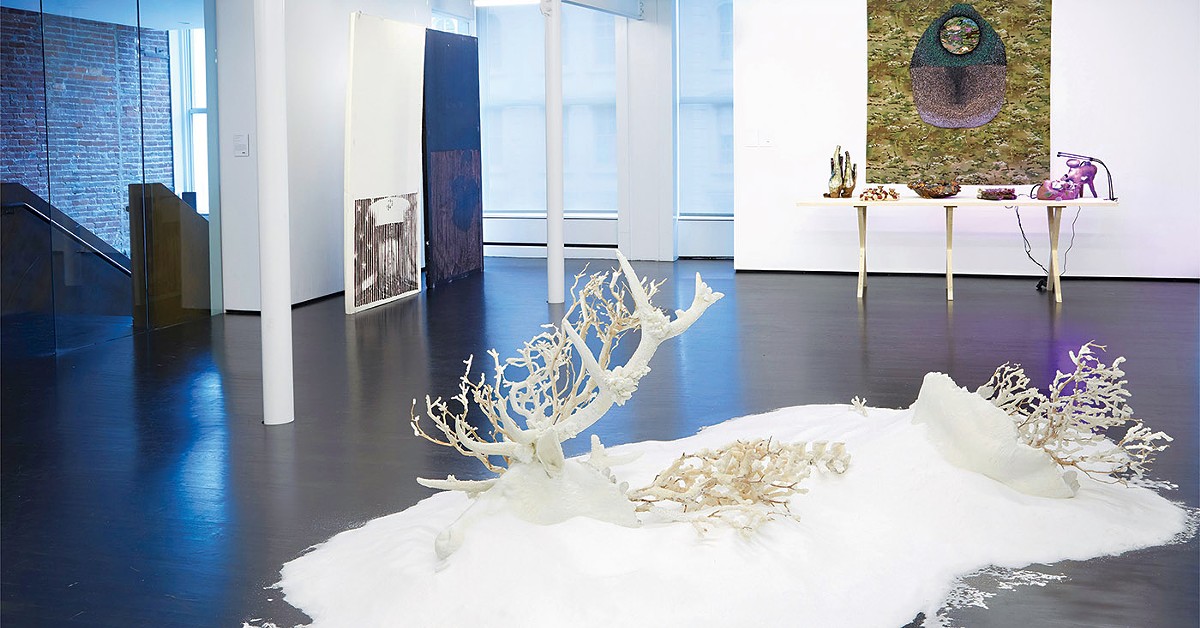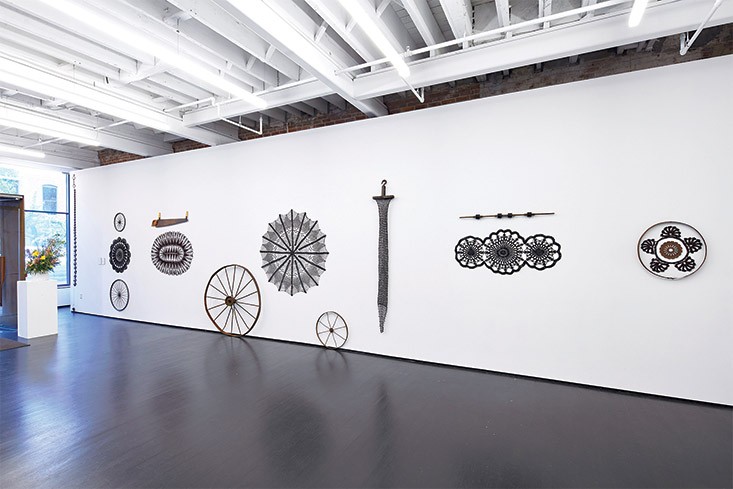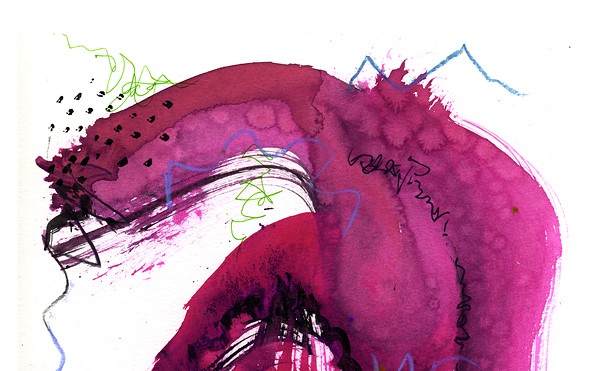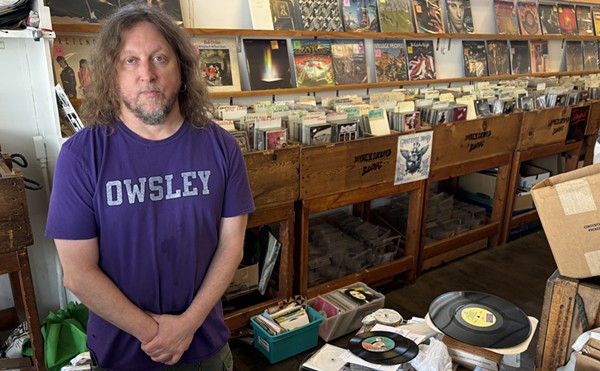The installation piece entitled “gentle platinum antibacterial pure essential botanical escapes” is composed of two, dark, wooden rectangular cases arranged in an L shape. The internal areas of the cases are open, revealing shelving and stairs. Placed neatly on the shelves are mason jars containing colorful liquids analogously arranged. On the white counter space created by the cases are pairs of open, rectangular bins, also containing colorful liquids matched in the same manner. Pleasant smells waft from these bins, making this tidy scene of domesticity alluring. The undertone is ominous, though, because this is ultimately a trap. The pleasantly scented dish soap is as close to escape as it’s going to get, as women are bound by the remarkably persistent view of being primarily homemakers.
The artist, Kristin Richards, is one of 20 artists selected to represent Kentucky’s contemporary art scene in KMAC Museum’s inaugural triennial exhibit entitled “Crown of Rays,” the name of which is inspired by a cultivated plant within the genus Goldenrod, the official state flower of Kentucky. “We’re thrilled to introduce this new triennial exhibition of contemporary art to the region,” KMAC Museum Curator Joey Yates said in a statement. “The selected artists reflect the biodiversity of the state, as each firmly stems from this environment and is a vibrant part of our contemporary art ecosystem.” More than 220 artists who spent formative years living in Kentucky submitted portfolios, from which the 20 were selected.
The three-floor show offers an impressive variety, with works ranging from video, sculpture and painting to kinetic and auditory installation pieces. The show is meant to highlight artworks that preserve certain traditions such as weaving, crocheting, drawing, painting and ceramics but also “the newer territories” of conceptual photography, video, sound, installation and performance, the museum said.
Weaver Philis Alvic moves away from the two-dimensional fabric plane in the displayed pieces from her “Portal” series. In “City Window,” a lattice composed of smaller grids is framed by drapery. One drape is tied back, and the other is loose, with an additional, smaller piece freely hanging behind it, suggesting motion, possibly wind. The colors are muted save for a central rectangle that is a bright, vibrant blue, giving the composition depth and focus. In this work, traditional craft meets contemporary composition. The cityscape is flattened and compressed into a structured circuit board, referencing industrialization and is juxtaposed with the hands-on process of weaving.
The crocheted works of Bette Levy also combine craft with contemporary, in a more rustic manner. The piece “Cognizant” is a mandala-like blend of industrial and craft. A metal barrel rim surrounds a nylon doily, which in turn surrounds a cog wheel. The crocheted pattern of the doily echoes the structure of the cog wheel. Here layers of time meet. The wheel, an old, basic tool, is blended with the delicate yet practical art of fabric making which, in turn, alludes to a more complex machine in the cogwheel. A progression of skill and the interrelationship of male and female is represented in this piece.
Andrew Cozzens’ installation “I’m Sorry We Are Meeting Under These Circumstances” features three paper shredders mounted on the wall. They are equipped with motion sensors, which activate to shred spools of paper printed with images of extinct animals, flora and so on. Piled on the floor below is the mound of images that have been destroyed. As the viewer walks by, they contribute to the destruction. Once the paper is completely shredded, the machines are left empty but still functioning, operating needlessly. Time is kinetic in this piece. The spools of paper becoming smaller give a visual representation of time running out. We are drawn into this sense of urgency by our passive interaction with the shredders. Simply by observing, we are contributing, and this piece makes us pointedly aware of that.
Photographer Casey James Wilson created a series of images specifically from the KMAC gallery space, using mirrors and empty spaces. Depth and two-dimensionality exist simultaneously in these works. The line and corner of the wall meeting the floor can also be seen as a vertical line intersecting into a wide angle, thus creating a broad, neutral space. The nested images reflected in the mirrors can draw the eye in, or they can be seen as a simple layering of flat shapes. These resulting grayscale compositions have a sublime beauty and empirical quality to them, reminiscent of Mondrian in their reduction of space to geometric form.
This is a mere one quarter of the artists represented in this complex and thought provoking exhibit. The artists took this opportunity to address a wide array of social, political and artistic concerns and the mediums used are mere footnotes to the expertise represented. This “Crown of Rays” radiates an impressive light. •
‘KMAC TRIENNIAL Crown of Rays’
Through Dec. 1
KMAC Museum
715 W. Main St.
Free | Times vary







